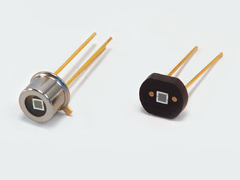Positron Emission Tomography
Our research topic:
We study the application of novel semi-conductor based photo-detectors such as Silicon Photomultipliers and SPAD photo-sensors implemented in CMOS technology to time-of-flight Positron Emission Tomography (short introduction to PET).
Silicon Photomultiplier

Figure 1: MPPC devices from HAMAMATSU
Silicon Photomultipliers (SiPM) or Multi-Pixel Photon Counter (MPPC,
HAMAMATSU
, see figure 1) are very compact
devices with an excellent photon counting capability. They provide a high quantum efficiency and
deliver a fast response. This results in an excellent energy and time resolution when coupled to
fast inorganic scintillators. Compared to conventional photomultiplier tubes they can be operated
at low voltages and are insensitive to magnetic fields. Due to their small size they allow the design
of detectors with unprecedented granularity resulting in a high spatial resolution.
SiPM devices are made up of multiple APD (avalanche photodiode) pixels operated in Geiger mode.
The sum of the output from each APD pixel forms the MPPC output. This allows the counting of
single photons or the detection of multiple photons.
SPAD photo-sensors implemented in CMOS technology
SPAD photo-sensors implemented in CMOS technology are novel photo-detectors allowing to measure the time of arrival of individual photons by means of integrated time-to-digital converter.

